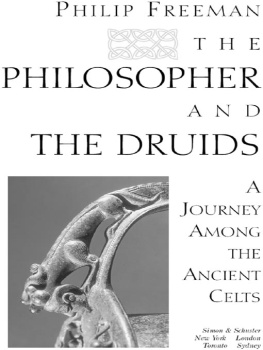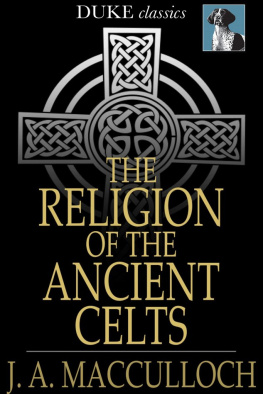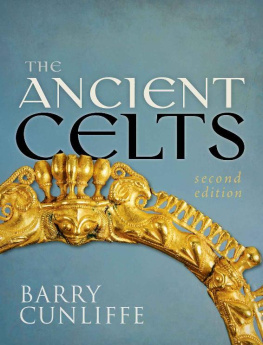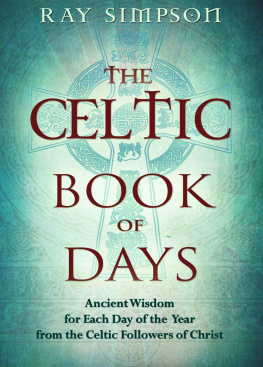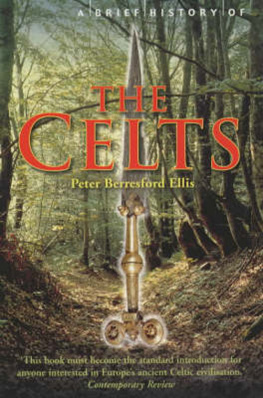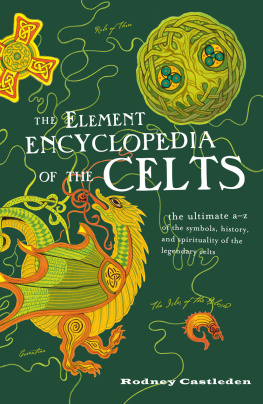Patricia King
The Celts have always inspired curiosity and awe. From earliest times to the present day, very little is known about these elusive and mysterious people. To the early Greeks and Romans they were the foreigners living to the north beyond their borders. The Greeks called them Keltoi because they seemed hidden and strange; the Romans called them Galli. We do not know by what name these prehistoric Celts were known between themselves. Their learned leaders, Druids and Filidh, had a prohibition against writing. All their lore had to remain hidden, stored in the minds and hearts of the seers who formed the learned class. This closely guarded oral tradition was entrusted only to chosen initiatesto be learned by heart, pondered over in years of study and training in eloquence, and handed down from generation to generation to form a communal memory. What we do know about these ancient Celts comes to us in fragmentary form, culled from references in classical writings; from archeologists and linguistic scholars; and from the remnants of the tradition that were finally committed to writing by Irish monks, starting in the sixth century A.D.
When we consider how much of the Celtic past is missing or extinct, and the gaps in our knowledge of what we have left, we cannot but feel an enormous sense of absence and loss. The remnants that remain, splendid as they may be, are merely what the poet John Montague calls shards of a lost tradition. Nevertheless, they are precious shards, like pieces of a stained glass window, which when reconstructed illuminates the past. The task of reconstruction sets us on a mythic quest across an ancient landscape in search of the grail that contains the wisdom of the Celts. We may never find intact this reliquary of the Celtic mind, but this makes us strive all the harder to follow the clues given in the traces we can find. The Greek and Roman writings are of some help in this quest, but we must remind ourselves that they were hostile witnesses; by the time they got close enough to the Celts to come up with any description, the Celts were a powerful adversary challenging Rome in its struggle for empire and world domination. The writings of the Christian monks retrieve only a fraction of the material, and they contain interpolations that demonstrate an ambiguous and conflicted attitude towards the preChristian past. As for archeology, only a small number of sites have so far been explored, and some of those explored have yet to be properly recorded. These sites are scattered all over Europe, and even farther afield, awaiting discovery and interpretation. In his long poem The Rough Field, itself a poetic field of force, drawing power from the past, Montague expresses this tantalizing truth:
Scattered over the hills,
tribal and placenames, uncultivated pearls.
No rock or ruin, dun or dolmen
But showed memory defying cruelty
Through an imageencrusted name.
The whole landscape a manuscript
We had lost the skill to read,
A part of our past disinherited;
But fumbled like a blind man,
Along the fingertips of instinct.1
As the technological aspect of archeological research improves, scholars are developing ever more exact tools for reading the landscape of the Celtic past. Since for the first millennium of their existence the Celts put nothing in writing, it is vitally important that we learn how to read and interpret the eloquent symbolism inscribed in the archeological and artistic heritage. By piecing together what we can glean from the evidence of archeology with the heroic narratives that began to be written down from the sixth century A.D., we get an aweinspiring glimpse of a significant civilization underpinning the foundations of Europe, and foreshadowing in its social structure the kind of unity in diversity that constitutes the vision for the future of the expanding European Union.
It is generally agreed that the Continental Celts were first encountered in North Central Europe; the earliest archeological trace we find of their presence places them at the headwaters of the Danube, Rhine, and Rhne (rivers still to this day bearing their Celtic names). One of the first recorded mentions of these prehistoric peoples is by the Greek historian Herodotus, stating that the Danube has its source in the territory inhabited by the Celts. Linguistically this makes sense, since the Danube gets its name from the Celtic mothergoddess, Danu. Archeological exploration confirms this view; some of the earliest Celtic finds have been in late Bronze Age and Iron Age cemeteries in the area of Austria known as Hallstatt. This remote region was notable in ancient times for its rocksalt mines; salt was an important commodity in those days for preserving food, and along with iron, gold, and silver, provided these early Celtic peoples with a valuable trading edge and a growing prosperity. Since salt also effectively preserves organic remains, archeological exploration around the Hallstatt salt deposits has yielded valuable insights into Celtic life in the last millennium B.C. Because of these finds, the Celtic period from approximately 800400 B.C. has become known as the Hallstatt Era. From the upper Danube region, the Iron Age Celts migrated and expanded their settlements until they occupied an area of Western Europe stretching from Gaul (France), to Iberia (Portugal and Spain). The Celts also migrated to Ireland and Britain in two wavesGoidels (Gaels) to Ireland and Brythons to Britain. The Celtic languages spoken by these insular Celts survive to this day among a small portion of the populations of these countries, in the form of modern Welsh, Irish, Scots Gaelic, and Breton. The languages spoken by the prehistoric Celts had a great deal of diversity, but enough in common to be recognizably ProtoCeltic, designated by linguists as an IndoEuropean language coming from the same source as Sanskrit, the classical language of the Hindus. From archeology as well as philology we find that the Celts made their first appearance in Western Europe at much the same time as similar migrations of peoples took place into India and Persia. The many similarities between the languages and worldviews of the Celts and the Hindus may suggest that both branch out from a common source in the prehistoric past somewhere in the steppes of Eurasia.
By the close of the fifth century B.C., the material life and culture of the Celts had become both prosperous and artistically sophisticated. Material evidence of this advance was uncovered on the banks of Lake Neuchtel in Switzerland at a place called La Tne, hence becoming known as the La Tne period in Celtic civilization. These artifacts confirm the existence of a culture rich in acquisitions and resources, with an exquisite art and an extensive trade in luxurious commodities. La Tne Celts had by then expanded from their central base in Switzerland and southern Germany west into the Balkans, Transylvania, and Bohemia (the present day Czech Republic). They had also developed a network of trade routes within Europe and along the Mediterranean coast during this time. Gradually the multiple and diverse groups of early Celtic peoples, through migration or conquest, occupied large portions of Europe. Besides the


